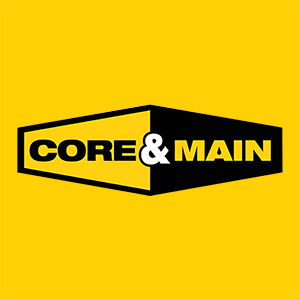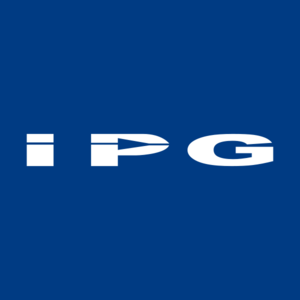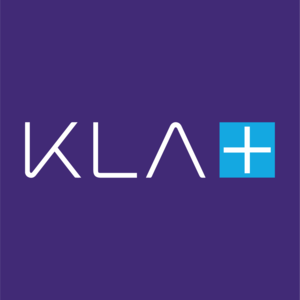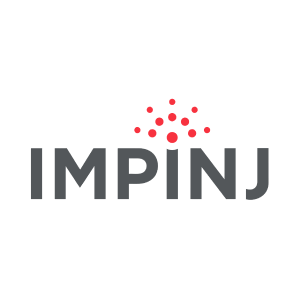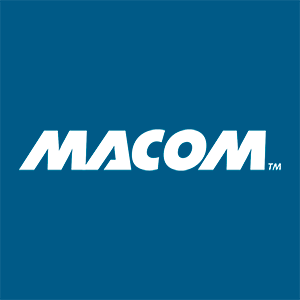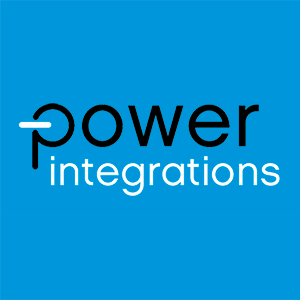
Himax (HIMX)
We wouldn’t recommend Himax. Its underwhelming revenue growth and failure to generate meaningful free cash flow is a concerning trend.― StockStory Analyst Team
1. News
2. Summary
Why We Think Himax Will Underperform
Taiwan-based Himax Technologies (NASDAQ:HIMX) is a leading manufacturer of display driver chips and timing controllers used in TVs, laptops, and mobile phones.
- Sales are projected to tank by 4.4% over the next 12 months as its demand continues evaporating
- Gross margin of 30.5% is below its competitors, leaving less money to invest in areas like marketing and R&D
- Products and services are facing significant end-market challenges during this cycle as sales have declined by 6% annually over the last two years


Himax’s quality doesn’t meet our bar. We’ve identified better opportunities elsewhere.
Why There Are Better Opportunities Than Himax
High Quality
Investable
Underperform
Why There Are Better Opportunities Than Himax
Himax is trading at $8.01 per share, or 51.6x forward P/E. This valuation multiple seems a bit much considering the tepid revenue growth profile.
We’d rather invest in similarly-priced but higher-quality companies with more reliable earnings growth.
3. Himax (HIMX) Research Report: Q3 CY2025 Update
Semiconductor maker Himax Technologies (NASDAQ:HIMX) reported Q3 CY2025 results beating Wall Street’s revenue expectations, but sales fell by 10.5% year on year to $199.2 million. Its GAAP profit of $0.01 per share was in line with analysts’ consensus estimates.
Himax (HIMX) Q3 CY2025 Highlights:
- Revenue: $199.2 million vs analyst estimates of $186.2 million (10.5% year-on-year decline, 7% beat)
- EPS (GAAP): $0.01 vs analyst estimates of $0 (in line)
- Adjusted EBITDA: $5.12 million (2.6% margin, 57% year-on-year decline)
- Operating Margin: -0.3%, down from 2.6% in the same quarter last year
- Free Cash Flow was $855,000, up from -$5.69 million in the same quarter last year
- Inventory Days Outstanding: 90, up from 83 in the previous quarter
- Market Capitalization: $1.59 billion
Company Overview
Taiwan-based Himax Technologies (NASDAQ:HIMX) is a leading manufacturer of display driver chips and timing controllers used in TVs, laptops, and mobile phones.
Himax was founded in 2001 by B.S. Wu, who pioneered flat panel technologies at Chimei Electronics as CTO. In March of 2006, Himax went public with a listing on the NASDAQ exchange.
Himax products primarily address the flat panel display industry. These products are critical components of displays ranging from TVs to driver displays to mobile phones and tablets. Himax’s emerging technologies include products such as WiseEye AI Image Sensing, which brings computer vision AI to endpoint devices such as smart doors and locks with extremely low power requirements.
The company’s customers are primarily panel manufacturers and mobile device module manufacturers, who in turn design their products for consumer end-use products such as notebook computers, desktop monitors, and TVs. Because Himax operates primarily in a fabless model that utilizes third-party foundries, the company relies on semiconductor manufacturing service providers for wafer fabrication, assembly, testing, and packaging.
Competitors in fabless display imaging semiconductors include Fitipower Integrated Technology (TPE:4961), FocalTech Systems (TPE:3545), Novatek Microelectronics (TPE:3034), and Raydium Semiconductor Corporation (TPE:3592).
4. Revenue Growth
A company’s long-term sales performance can indicate its overall quality. Any business can put up a good quarter or two, but many enduring ones grow for years. Regrettably, Himax’s sales grew at a tepid 2% compounded annual growth rate over the last five years. This was below our standards and is a poor baseline for our analysis. Semiconductors are a cyclical industry, and long-term investors should be prepared for periods of high growth followed by periods of revenue contractions.
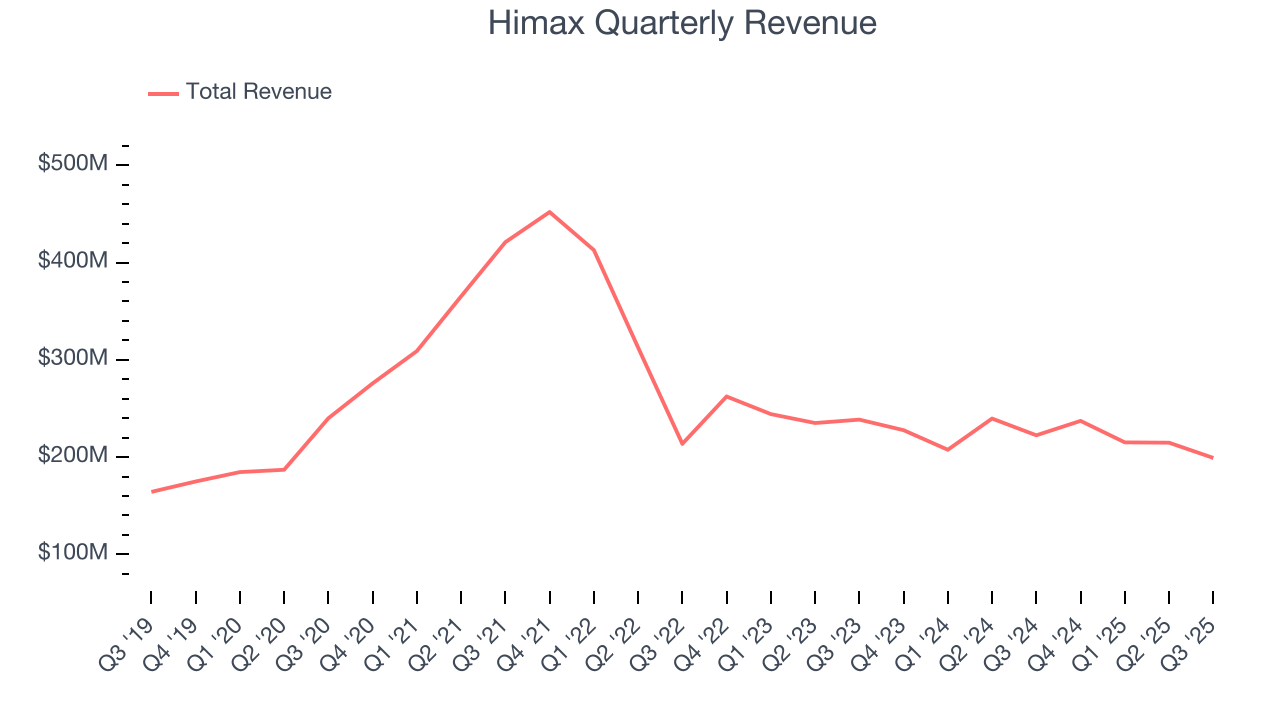
Long-term growth is the most important, but short-term results matter for semiconductors because the rapid pace of technological innovation (Moore's Law) could make yesterday's hit product obsolete today. Himax’s performance shows it grew in the past but relinquished its gains over the last two years, as its revenue fell by 6% annually. 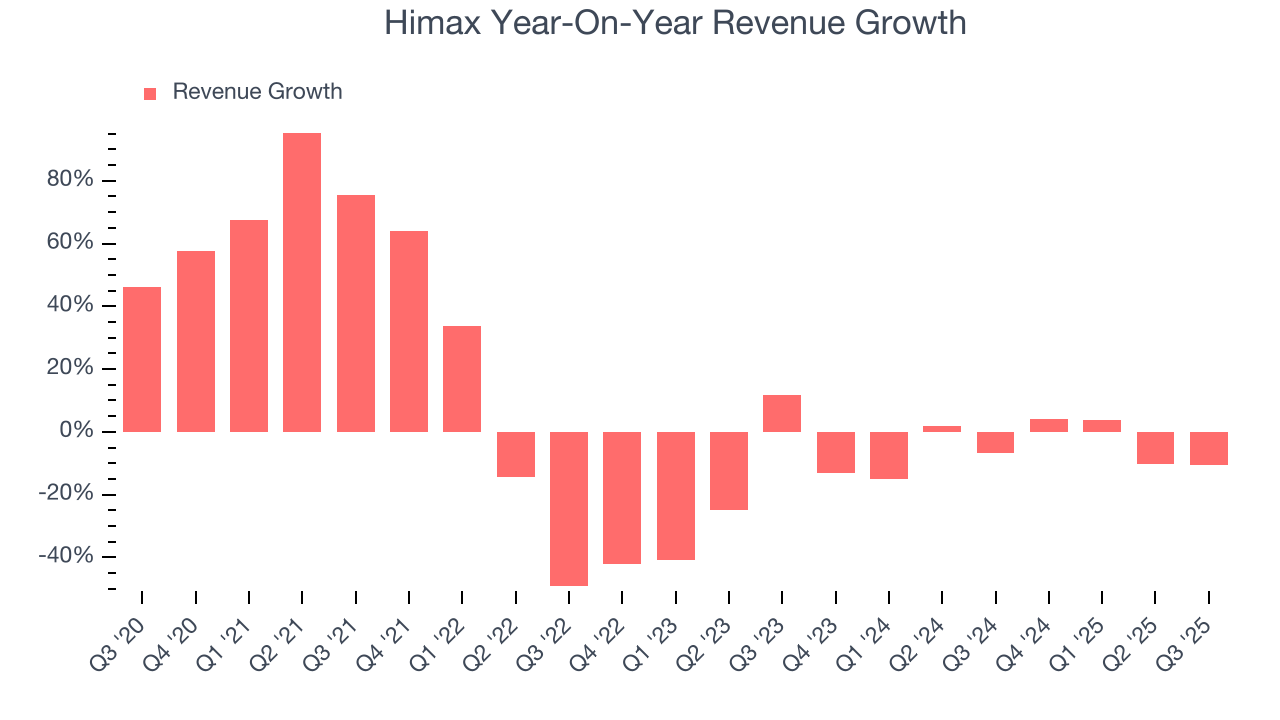
This quarter, Himax’s revenue fell by 10.5% year on year to $199.2 million but beat Wall Street’s estimates by 7%. Despite the beat, the drop in sales could mean that the current downcycle is deepening.
Looking ahead, sell-side analysts expect revenue to grow 2.7% over the next 12 months. Although this projection indicates its newer products and services will catalyze better top-line performance, it is still below the sector average.
5. Product Demand & Outstanding Inventory
Days Inventory Outstanding (DIO) is an important metric for chipmakers, as it reflects a business’ capital intensity and the cyclical nature of semiconductor supply and demand. In a tight supply environment, inventories tend to be stable, allowing chipmakers to exert pricing power. Steadily increasing DIO can be a warning sign that demand is weak, and if inventories continue to rise, the company may have to downsize production.
This quarter, Himax’s DIO came in at 90, which is 27 days below its five-year average. These numbers show that despite the recent increase, there’s no indication of an excessive inventory buildup.
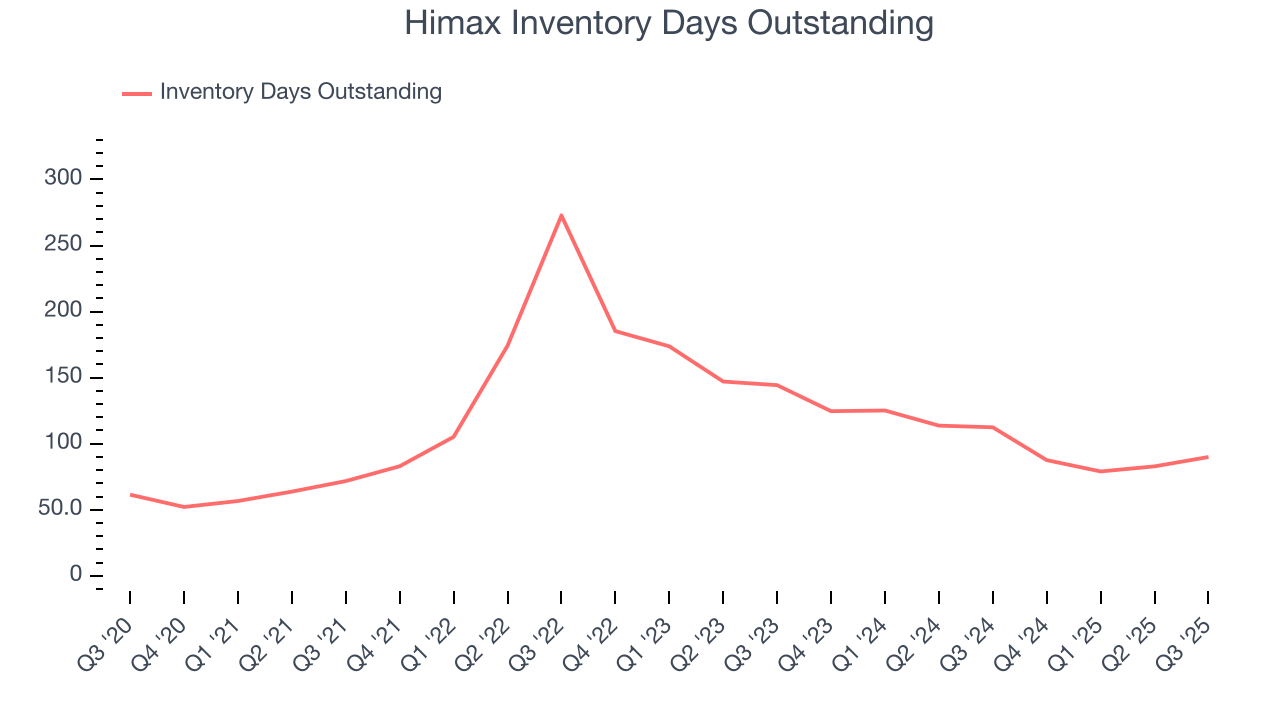
6. Gross Margin & Pricing Power
In the semiconductor industry, a company’s gross profit margin is a critical metric to track because it sheds light on its pricing power, complexity of products, and ability to procure raw materials, equipment, and labor.
Himax’s gross margin is one of the worst in the semiconductor industry, signaling it operates in a competitive market and lacks pricing power. As you can see below, it averaged a 30.5% gross margin over the last two years. That means Himax paid its suppliers a lot of money ($69.50 for every $100 in revenue) to run its business. 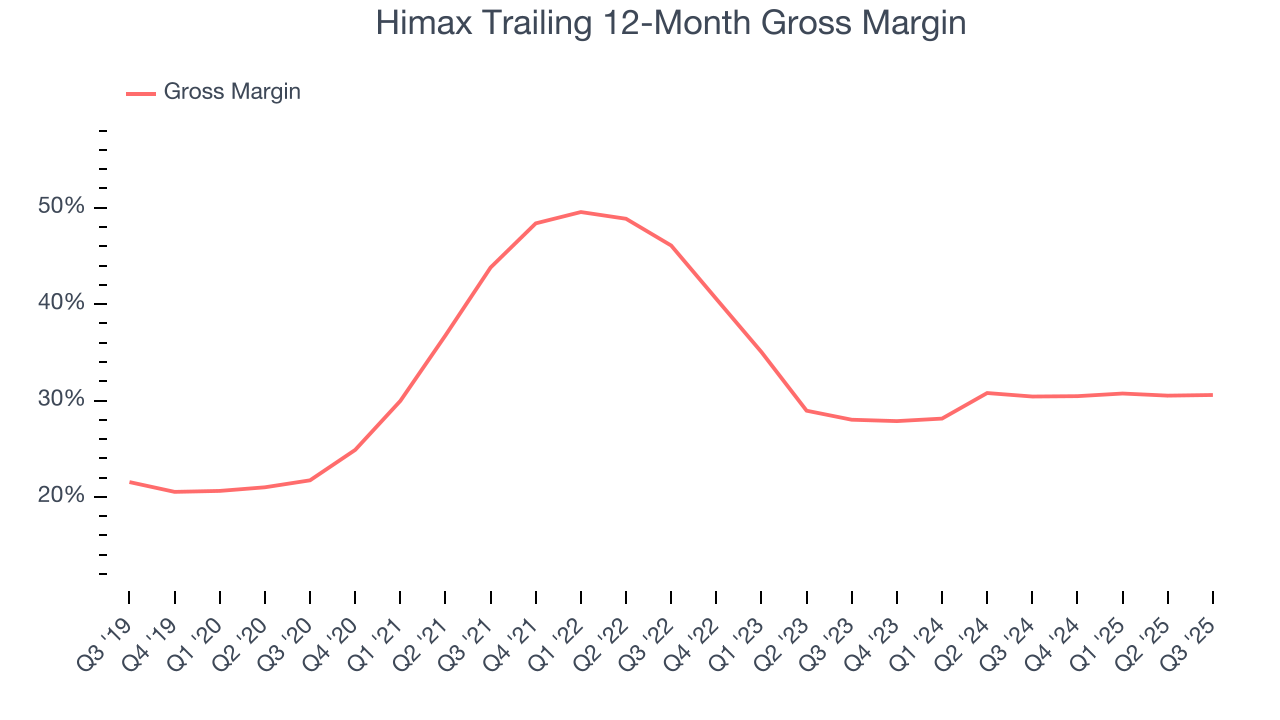
In Q3, Himax produced a 30.2% gross profit margin, in line with the same quarter last year. On a wider time horizon, the company’s full-year margin has remained steady over the past four quarters, suggesting its input costs (such as raw materials and manufacturing expenses) have been stable and it isn’t under pressure to lower prices.
7. Operating Margin
Himax was profitable over the last two years but held back by its large cost base. Its average operating margin of 6.9% was weak for a semiconductor business. This result isn’t too surprising given its low gross margin as a starting point.
Analyzing the trend in its profitability, Himax’s operating margin decreased by 22.9 percentage points over the last five years. This raises questions about the company’s expense base because its revenue growth should have given it leverage on its fixed costs, resulting in better economies of scale and profitability. Himax’s performance was poor no matter how you look at it - it shows that costs were rising and it couldn’t pass them onto its customers.
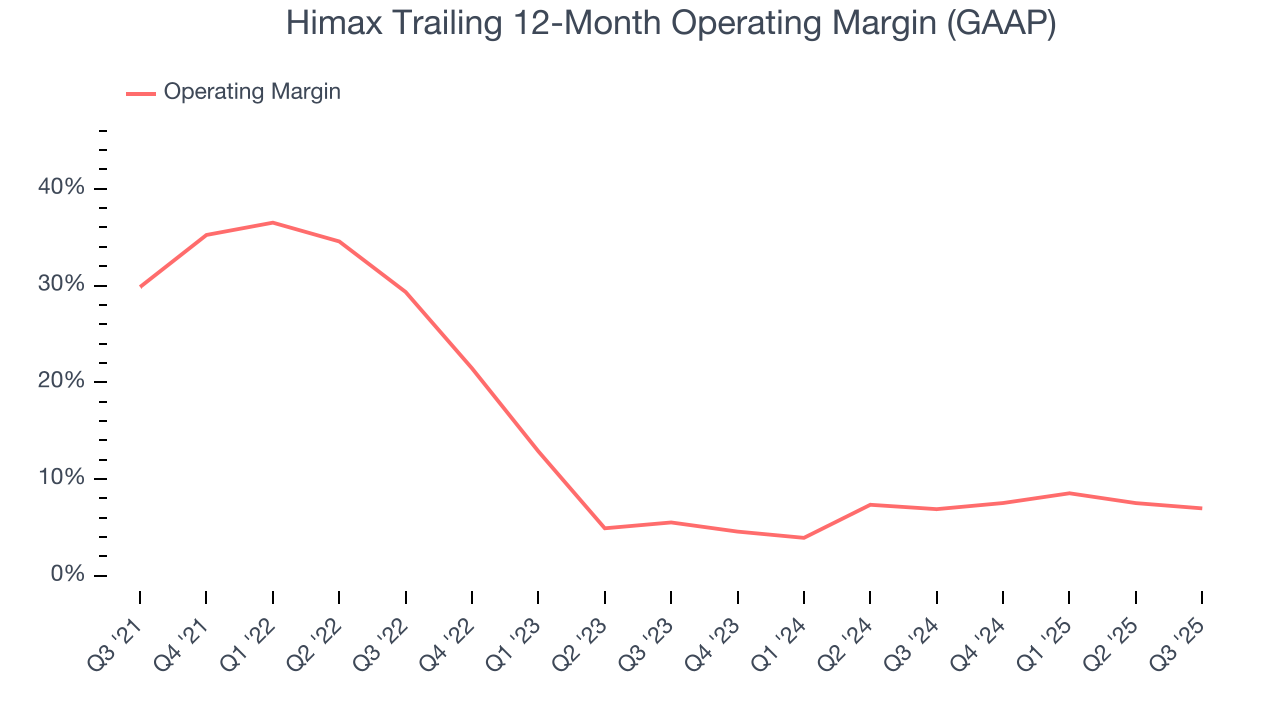
In Q3, Himax’s breakeven margin was down 2.9 percentage points year on year. Since Himax’s operating margin decreased more than its gross margin, we can assume it was less efficient because expenses such as marketing, R&D, and administrative overhead increased.
8. Earnings Per Share
Revenue trends explain a company’s historical growth, but the long-term change in earnings per share (EPS) points to the profitability of that growth – for example, a company could inflate its sales through excessive spending on advertising and promotions.
Himax’s EPS grew at an astounding 34.1% compounded annual growth rate over the last five years, higher than its 2% annualized revenue growth. However, we take this with a grain of salt because its operating margin didn’t improve and it didn’t repurchase its shares, meaning the delta came from reduced interest expenses or taxes.
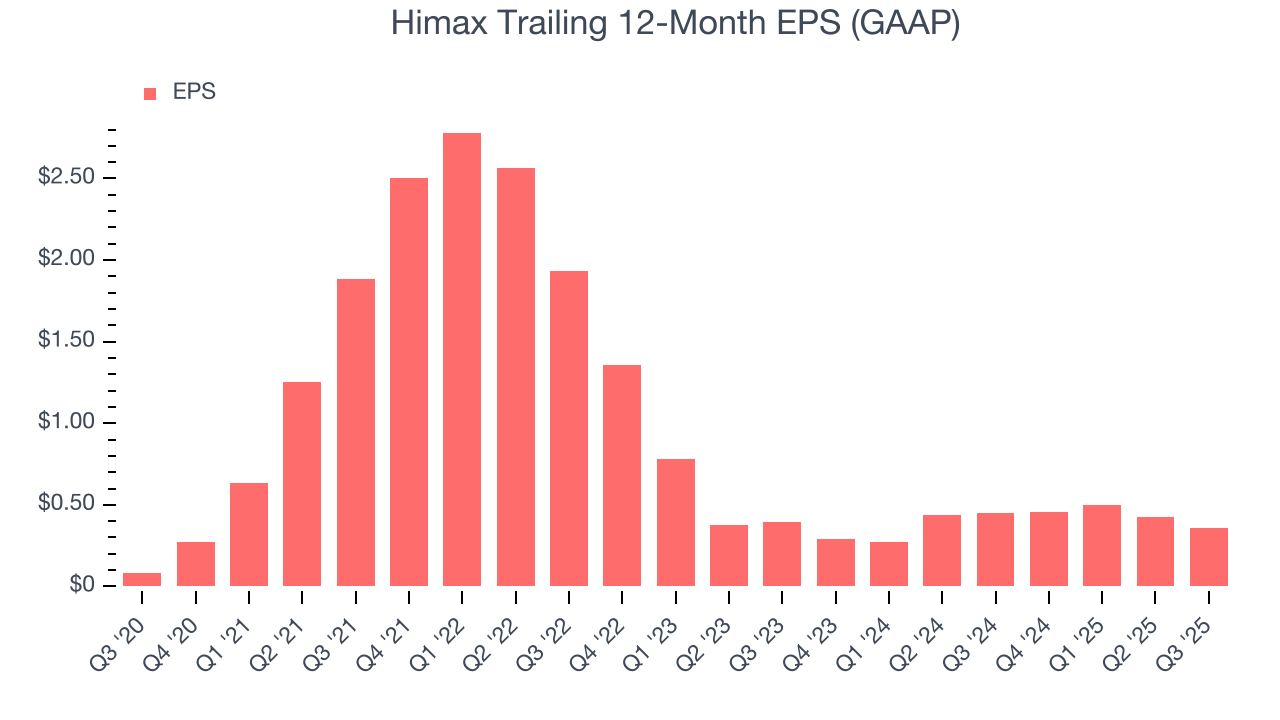
In Q3, Himax reported EPS of $0.01, down from $0.07 in the same quarter last year. Despite falling year on year, this print easily cleared analysts’ estimates. Over the next 12 months, Wall Street expects Himax’s full-year EPS of $0.36 to grow 23.9%.
9. Cash Is King
Although earnings are undoubtedly valuable for assessing company performance, we believe cash is king because you can’t use accounting profits to pay the bills.
Himax has shown mediocre cash profitability over the last two years, giving the company limited opportunities to return capital to shareholders. Its free cash flow margin averaged 15%, subpar for a semiconductor business.
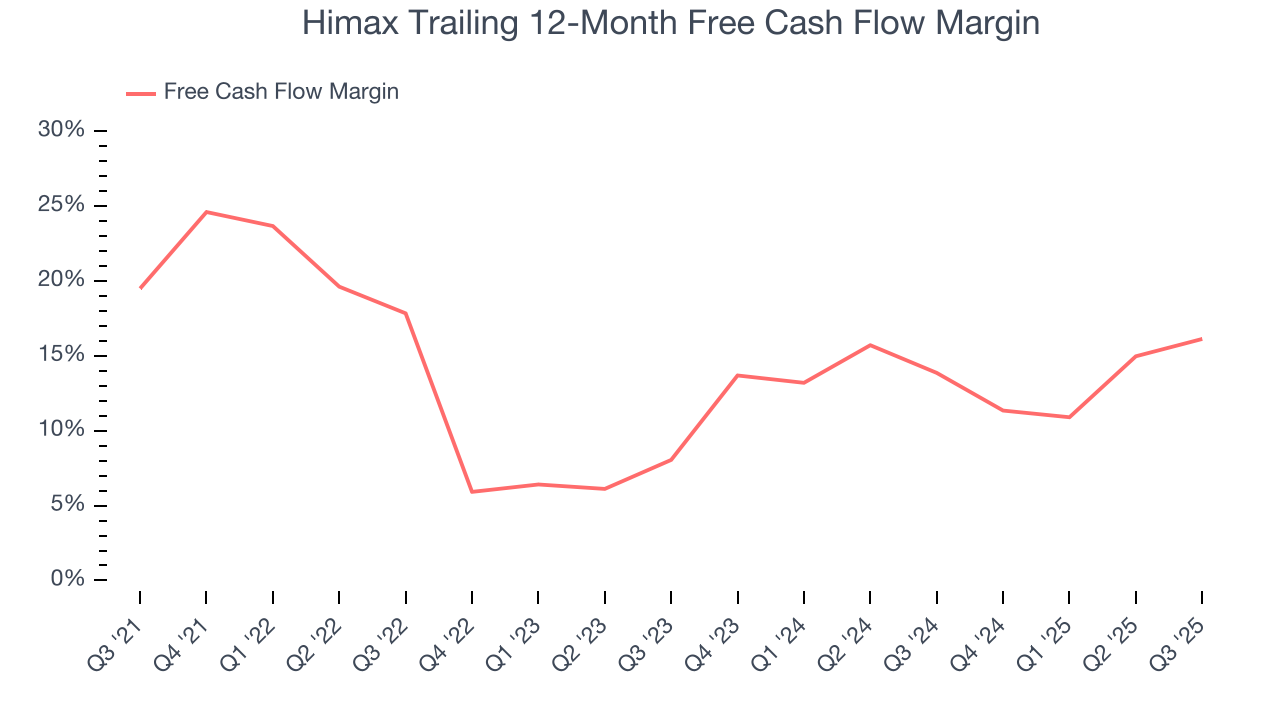
Himax broke even from a free cash flow perspective in Q3. This result was good as its margin was 3 percentage points higher than in the same quarter last year, but we wouldn’t read too much into the short term because investment needs can be seasonal, leading to temporary swings. Long-term trends trump fluctuations.
10. Return on Invested Capital (ROIC)
EPS and free cash flow tell us whether a company was profitable while growing its revenue. But was it capital-efficient? A company’s ROIC explains this by showing how much operating profit it makes compared to the money it has raised (debt and equity).
Although Himax hasn’t been the highest-quality company lately, it historically found a few growth initiatives that worked. Its five-year average ROIC was 28.4%, higher than most semiconductor businesses.
11. Balance Sheet Risk
As long-term investors, the risk we care about most is the permanent loss of capital, which can happen when a company goes bankrupt or raises money from a disadvantaged position. This is separate from short-term stock price volatility, something we are much less bothered by.
Himax’s $599.2 million of debt exceeds the $257.1 million of cash on its balance sheet. Furthermore, its 5× net-debt-to-EBITDA ratio (based on its EBITDA of $67.55 million over the last 12 months) shows the company is overleveraged.
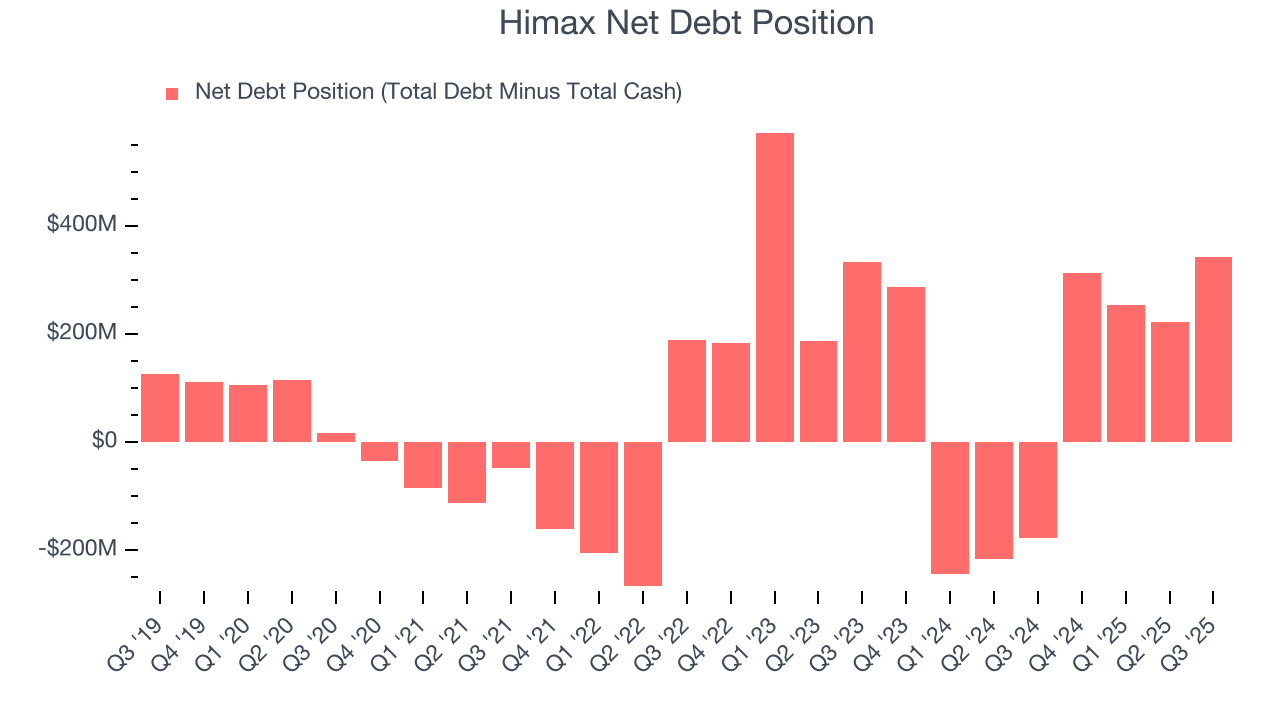
At this level of debt, incremental borrowing becomes increasingly expensive and credit agencies could downgrade the company’s rating if profitability falls. Himax could also be backed into a corner if the market turns unexpectedly – a situation we seek to avoid as investors in high-quality companies.
We hope Himax can improve its balance sheet and remain cautious until it increases its profitability or pays down its debt.
12. Key Takeaways from Himax’s Q3 Results
It was encouraging to see Himax meet analysts’ EPS expectations this quarter. We were also glad its revenue outperformed Wall Street’s estimates. On the other hand, its inventory levels materially increased. Zooming out, we think this was a good print with some key areas of upside. The market seemed to be hoping for more, and the stock traded down 4.1% to $8.71 immediately after reporting.
13. Is Now The Time To Buy Himax?
Updated: December 4, 2025 at 9:31 PM EST
Before investing in or passing on Himax, we urge you to understand the company’s business quality (or lack thereof), valuation, and the latest quarterly results - in that order.
We see the value of companies furthering technological innovation, but in the case of Himax, we’re out. To begin with, its revenue growth was uninspiring over the last five years, and analysts expect its demand to deteriorate over the next 12 months. And while its spectacular EPS growth over the last five years shows its profits are trickling down to shareholders, the downside is its projected EPS for the next year is lacking. On top of that, its declining operating margin shows the business has become less efficient.
Himax’s P/E ratio based on the next 12 months is 53.9x. This multiple tells us a lot of good news is priced in - we think there are better stocks to buy right now.
Wall Street analysts have a consensus one-year price target of $8.54 on the company (compared to the current share price of $8.24).

